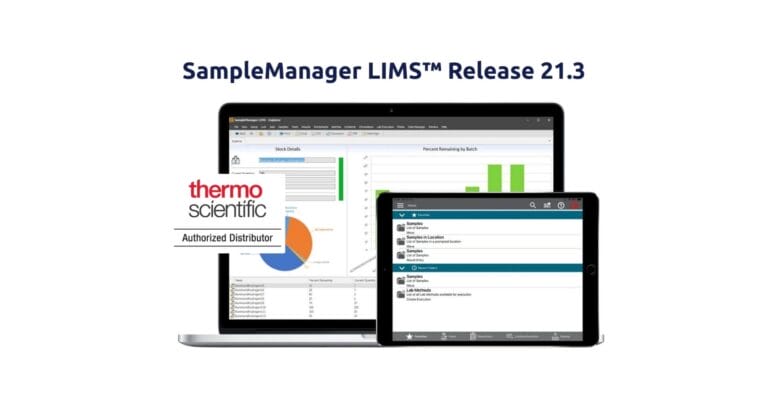Why even small Laboratories benefit from a LIMS
Advantages and Solutions for small and medium-sized Laboratories
Small and medium-sized laboratories face major challenges: limited resources, manual processes, and regulatory requirements. A LIMS can optimize laboratory processes and eliminate weak points, thus increasing laboratory efficiency. Find out how specially adapted digitalization solutions are a worthwhile investment, especially for small laboratories.
At present, innovative laboratories are faced with the challenges of processing ever-increasing volumes of samples and data, possibly meeting strict regulatory requirements, and working efficiently and cost-effectively at the same time. This applies not only to large laboratories, but also to small and medium-sized laboratories in particular, which often have to contend with even greater constraints in terms of budgets, resources, and personnel while remaining competitive in the long term.
While a laboratory information management system (LIMS) is often seen as a tool for large research institutions and companies, small and medium-sized laboratories can also benefit significantly from implementing a LIMS. In this article, we highlight the specific challenges faced by smaller laboratories and how a customized LIMS can help increase their efficiency and optimize their operations.
The Challenges of small and medium-sized Laboratories
1. Limited Resources and Personnel
One of the biggest challenges for small laboratories is the limitation of resources, both financially and in terms of personnel. In many cases, employees have to take on multiple roles, which can lead to an increased workload and a higher susceptibility to errors. For example, a laboratory employee could be responsible for performing analyses, creating reports, and managing data. However, this “multitasking approach” can lead to confusion and inefficiency.
2. Manual Processes and Data Management
In many smaller laboratories, manual processes are still used to record, manage and analyze data. This can take the form of Excel spreadsheets, handwritten notes or manually generated reports. However, these manual processes are error-prone, time-consuming, and often lead to a lack of data integrity. In addition, the lack of a central database can lead to a fragmented information landscape, which increases the risk of data loss or incomplete data sets.
3 Regulatory Requirements
Although small and medium-sized laboratories may not handle the same volume as larger research facilities, they still have to meet the same stringent regulatory requirements. This is especially true for laboratories operating in regulated sectors such as the pharmaceutical, medical, or food industries. Compliance with regulations such as Good Laboratory Practice (GLP), Good Manufacturing Practice (GMP) or ISO standards requires careful documentation and traceability of all data and processes.

4. Cost Control
Another important factor for smaller laboratories is cost control. Budgets for IT systems and software solutions are often limited and many small laboratories are therefore reluctant to invest in complex systems that they may not be able to fully utilize. The cost of purchasing, training, and maintaining a LIMS solution can initially be a deterrent for smaller laboratories.
The Advantages of a LIMS for small and medium-sized Laboratories
Despite these challenges, even small and medium-sized laboratories can benefit significantly from implementing a LIMS. A LIMS can solve many of the problems mentioned above by automating lab operations, centralizing data, and making the entire lab process more efficient. Some of the key benefits of a LIMS for smaller laboratory units are:
1. Automation and increased Efficiency
A LIMS can automate and streamline many of the manual processes that lead to inefficiencies in small laboratories. For example, data can be captured, stored, and analyzed automatically, reducing the need for manual entry and therefore the risk of transcription errors. By automating tasks such as sample collection and tracking, report generation, and data analysis, staff can focus on their core tasks while increasing the efficiency of the entire laboratory.
A LIMS reduces the time required to perform routine tasks. For example, recurring tasks such as creating reports or registering and managing samples can be automated with just a few clicks. This saves time and reduces the effort required for administrative tasks.
2. Improved Data Management and Integrity
One of the biggest advantages of a LIMS is the centralized management of all laboratory data. By introducing a LIMS, a central laboratory database is created in which all data is securely stored and easily accessible. This not only facilitates the management of samples and results, but also improves data integrity as all data is stored consistently and traceably.
Improved data integrity is particularly important for laboratories operating in regulated industries. By providing complete traceability of all steps in the laboratory process, a LIMS can help to meet the requirements of audits and regulatory checks.
3. Fulfillment of Regulatory Requirements
For small and medium sized laboratories operating in regulated areas, compliance is critical. A LIMS can help meet all regulatory requirements by ensuring complete documentation and traceability of all laboratory processes.
A LIMS offers functions such as audit trails, which make it possible to track every change or action in the system. This ensures that the laboratory always has complete and traceable documentation that meets the requirements of regulatory authorities. This not only facilitates the audit process, but also reduces the risk of non-compliance, which can lead to high fines or legal consequences.
4. Scalability and Flexibility
Another important advantage of LIMS is its scalability. Many modern LIMS solutions are designed to grow with the laboratory. This means that small laboratories can start with a basic LIMS configuration and expand the system as their workload or requirements change.
This flexibility is particularly important for laboratories working in a rapidly changing environment. With a scalable LIMS, the laboratory can ensure that it is also prepared for technological changes and growing requirements in the future.
5. Cost-Benefit Analysis: LIMS as Investment
Although there is an initial cost associated with implementing a LIMS, it should be viewed as a long-term investment. A LIMS can help to reduce operating costs by increasing efficiency, reducing error rates, and improving compliance. In addition, a LIMS enables transparent laboratory management, e.g. in terms of better utilization of available resources, which can further reduce the overall costs of laboratory operations.
In recent years, LIMS solutions have also become more affordable for small and medium-sized laboratories. Cloud-based LIMS offer a cost-effective way to take advantage of the benefits of a LIMS without having to make high initial investments in hardware and IT infrastructure.

How can up2LIMS from up to data be tailored specifically to small and medium-sized Labs?
A LIMS designed as an “all-in-one” solution directly for small and medium-sized laboratories and CROs is up2LIMS from up to data. We also place particular emphasis on a cost-effective coaching-based approach to implementation to ensure that the requirements for your laboratory can be implemented perfectly, appropriately and cost-effectively – always in close cooperation with your laboratory team. With up2LIMS we deliberately focus on:
1. User-Friendliness
For small laboratories that may not have a large IT team, the user-friendliness of a LIMS is crucial. An intuitive and easy-to-use system can make implementation and ongoing operation much easier and reduce the amount of training required for staff.
2. Configurability
A LIMS should be flexible enough to meet the individual requirements of even smaller laboratory units. A modular structure ensures that only the functions that are needed are activated, while other functions can be added later as the laboratory grows.
3. Cloud-Based Solutions
For small and medium-sized laboratories that may not have an extensive IT infrastructure, a cloud-based LIMS solution can be an attractive option. Cloud-based LIMSs do not require investment in expensive hardware while offering the ability to access lab data from any location.
Conclusion
Small and medium-sized laboratories face many challenges, from limited resources and complex regulatory requirements to manual processes that are inefficient and error-prone. A LIMS provides a powerful digitization solution to overcome these challenges and ensure laboratory efficiency, process safety and compliance.
By implementing a scalable and customized LIMS, small and medium-sized laboratories can not only optimize their operations but also remain competitive by benefiting from the same technological advances as larger laboratories. A LIMS should be viewed as a long-term investment that enables the laboratory to work more efficiently, minimize errors and meet the requirements of regulatory authorities.
Ultimately, LIMS are also worthwhile in small and medium-sized laboratories and can make the difference between smooth, efficient operation, and a time-consuming error-prone process. Implementing a LIMS is therefore not only a question of scaling, but also a question of future-proofing for laboratories of all sizes.
This content might also interest you
You have Questions – We have Your Solutions





